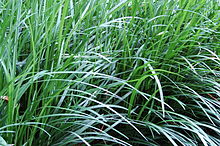| Ophiopogon | |
|---|---|

| |

| |
| Ophiopogon japonicus | |
| Scientific classification | |
| Kingdom: | Plantae |
| Clade: | Tracheophytes |
| Clade: | Angiosperms |
| Clade: | Monocots |
| Order: | Asparagales |
| Family: | Asparagaceae |
| Subfamily: | Nolinoideae |
| Genus: | Ophiopogon Ker Gawl. |
| Synonyms[1] | |
| |
Ophiopogon (lilyturf)[2] is a genus of evergreen perennial plants native to warm temperate to tropical East, Southeast, and South Asia.[1][3] Despite their grasslike appearance, they are not closely related to the true grasses, the Poaceae. The name of the genus is derived from Greek ὄφις ophis, 'snake' and πώγων pogon, 'beard', most probably referring to its leaves and tufted growth.[4][5][6][7] In the APG III classification system, it is placed in the family Asparagaceae, subfamily Nolinoideae (formerly the family Ruscaceae).[8] Like many lilioid monocots, it was formerly classified in the Liliaceae.
They grow from short rhizomes, and bear tufts of leaves, from which flowers emerge in racemes held on short stems above the leaves.
- Species[1]
- Ophiopogon acerobracteatus - Guangdong
- Ophiopogon albimarginatus - Guangxi
- Ophiopogon amblyphyllus - Sichuan, Yunnan
- Ophiopogon angustifoliatus - S China
- Ophiopogon bockianus - S China, Vietnam
- Ophiopogon bodinieri - China, Bhutan
- Ophiopogon brevipes - Thailand
- Ophiopogon caulescens - SE Asia
- Ophiopogon chingii - S China
- Ophiopogon clarkei - C + E Himalayas
- Ophiopogon clavatus - S China
- Ophiopogon confertifolius - Thailand
- Ophiopogon cordylinoides - N Myanmar
- Ophiopogon corifolius - Guangxi, Guizhou
- Ophiopogon dracaenoides - S China, N Indochina, E Himalayas
- Ophiopogon filipes - Guangxi
- Ophiopogon fooningensis - Yunnan
- Ophiopogon grandis - Yunnan, Guizhou, Myanmar
- Ophiopogon heterandrus - S China
- Ophiopogon hongjiangensis - Yunnan
- Ophiopogon humilis - Cambodia, Vietnam
- Ophiopogon intermedius - S China, S + SE Asia
- Ophiopogon jaburan - Korea, Jeju-do, Japan, Nansei-shoto
- Ophiopogon japonicus - E Asia, Philippines
- Ophiopogon jiangchengensis - Yunnan
- Ophiopogon kradungensis - Thailand
- Ophiopogon latifolius - Yunnan, Guangxi, Vietnam
- Ophiopogon leptophyllus - Assam
- Ophiopogon longifolius - Vietnam
- Ophiopogon lushuiensis - Yunnan
- Ophiopogon mairei - S China
- Ophiopogon malcolmsonii - Myanmar
- Ophiopogon marmoratus - S China, N Indochina
- Ophiopogon megalanthus - Yunnan
- Ophiopogon menglianensis - Yunnan
- Ophiopogon micranthus - Assam
- Ophiopogon motouensis - Tibet
- Ophiopogon multiflorus - Guangxi
- Ophiopogon ogisui - Guangxi
- Ophiopogon paniculatus - Sichuan
- Ophiopogon peliosanthoides - S China, Vietnam
- Ophiopogon pierrei - Cambodia
- Ophiopogon pingbienensis - Yunnan
- Ophiopogon planiscapus - Japan
- Ophiopogon platyphyllus - S China, Vietnam
- Ophiopogon pseudotonkinensis - Guangxi
- Ophiopogon regnieri - Vietnam
- Ophiopogon reptans - S China, N Indochina, Assam
- Ophiopogon reversus - Guangxi, Hainan
- Ophiopogon revolutus - Yunnan, Thailand
- Ophiopogon sar-garhwalensis - Uttarakhand
- Ophiopogon sarmentosus - Yunnan, Guangxi
- Ophiopogon siamensis - N Thailand
- Ophiopogon sinensis - Yunnan, Guangxi
- Ophiopogon sparsiflorus - Guangxi, Guangdong
- Ophiopogon stenophyllus - S China
- Ophiopogon subverticillatus - Vietnam
- Ophiopogon sylvicola - Sichuan, Guizhou
- Ophiopogon szechuanensis - Sichuan, Yunnan
- Ophiopogon tienensis - Yunnan, Guangxi
- Ophiopogon tonkinensis - Yunnan, Guangxi, Vietnam
- Ophiopogon tsaii - Yunnan
- Ophiopogon umbraticola - S China
- Ophiopogon vietnamensis - Vietnam
- Ophiopogon xylorrhizus - Yunnan
- Ophiopogon yunnanensis - Yunnan
- Ophiopogon zingiberaceus - Sichuan, Yunnan
- ^ a b c Kew World Checklist of Selected Plant Families
- ^ RHS A-Z encyclopedia of garden plants. United Kingdom: Dorling Kindersley. 2008. p. 1136. ISBN 978-1405332965.
- ^ Flora of China Vol. 24 Page 252 沿阶草属 yan jie cao shu Ophiopogon Ker Gawler, Bot. Mag. 27: t. 1063. 1807.
- ^ Germplasm Resources Information Network: Ophiopogon Archived 2009-01-15 at the Wayback Machine
- ^ Flora of China: Ophiopogon
- ^ Huxley, A., ed. (1992). New RHS Dictionary of Gardening. Macmillan ISBN 0-333-47494-5.
- ^ When Perennials Bloom: An Almanac for Planning and Planting By Tomasz Aniśko pg 342
- ^ Chase, M.W.; Reveal, J.L. & Fay, M.F. (2009), "A subfamilial classification for the expanded asparagalean families Amaryllidaceae, Asparagaceae and Xanthorrhoeaceae", Botanical Journal of the Linnean Society, 161 (2): 132–136, doi:10.1111/j.1095-8339.2009.00999.x